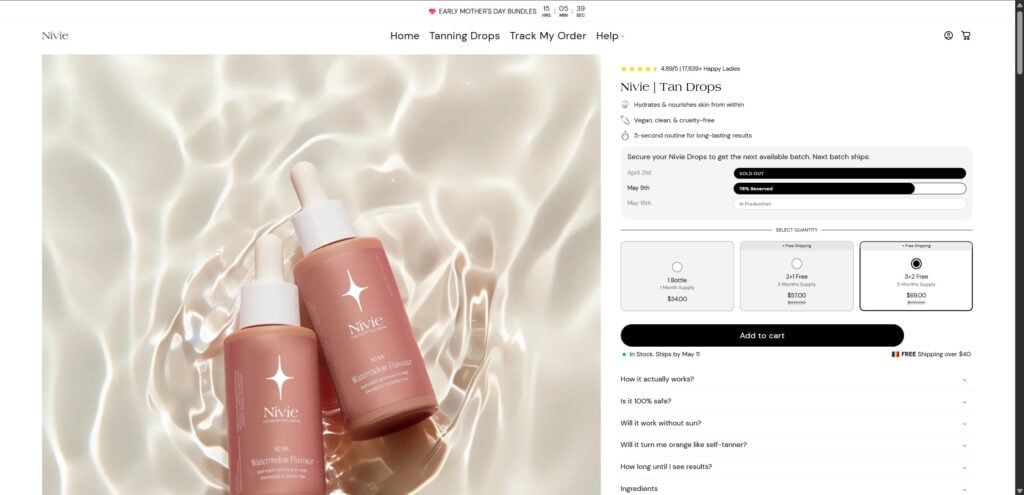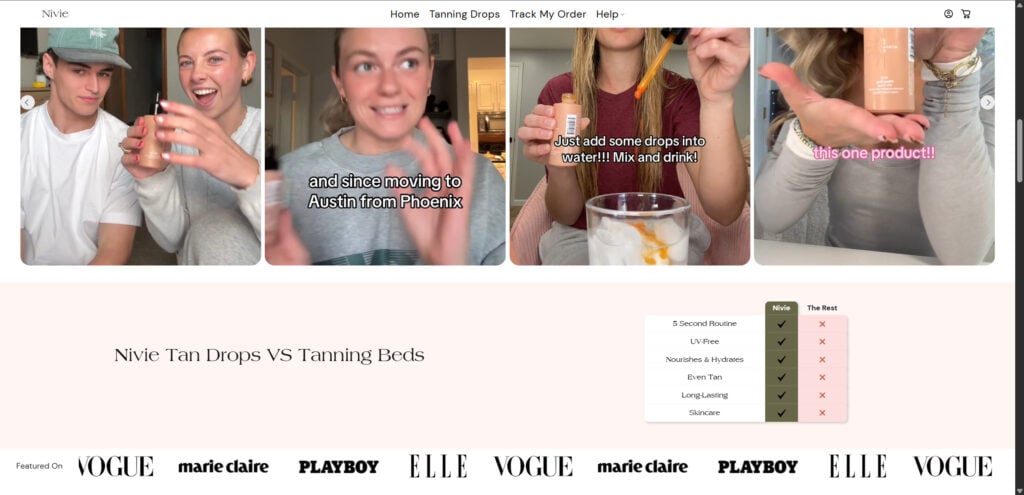Nivie Tanning Drops have exploded across social media, promoted as a fast, effortless way to achieve a sun-kissed glow—without the need for UV rays, self-tanners, or time spent outdoors. Marketed as a skincare-meets-tanning solution that boosts your natural melanin levels from within, these drops promise visible tanning results in as little as 7 to 10 days. But can a few drops mixed into water really tan your skin from the inside out? Or is Nivie simply another product wrapped in trendy aesthetics and clever marketing?
This review breaks down the product’s claims, ingredients, marketing tactics, and customer feedback to uncover the truth behind the hype.

Nivie Tan Drops Overview
At first glance, Nivie Tan Drops present a clean, premium image. With stylish packaging, glowing influencer endorsements, and claims of being “UV-free” and “science-backed,” the product appears legitimate. But when we take a closer look, multiple warning signs begin to appear.
1. Unscientific Claims About Melanin Production
The foundational promise behind Nivie Tanning Drops is that they can increase melanin production without sunlight. This is misleading. Melanin—the pigment responsible for skin color—is naturally triggered by UV exposure. Without that stimulus, there is little biological reason for your body to produce more of it.
The ingredient list includes beta-carotene, copper, and tyrosine—compounds that may support general skin health, but they do not trigger the body to create a visible tan on their own. The claim that Nivie can darken your skin tone internally without sun or artificial UV exposure lacks scientific validation.

2. Ambiguous Product Labeling and Ingredient Transparency
Another concern is the vague ingredient information. The product does not disclose exact concentrations or scientific rationale behind the proprietary blend. This lack of transparency makes it difficult to determine whether the dosages used are effective—or even safe.
Terms like “hydrating,” “glow-enhancing,” and “nourishing” are repeated without specifics. What does it mean to hydrate the skin from within? What studies back these benefits? The answers aren’t provided.
3. Fake Scarcity and Urgency Tactics
The Nivie website often displays urgent messages like “78% reserved,” “SOLD OUT,” and “Next batch ships on [date]” regardless of when you visit. These are classic sales triggers meant to induce FOMO (Fear of Missing Out). It creates unnecessary pressure, pushing buyers to make decisions without adequate research.
This is a hallmark of dropshipping-style websites that prioritize high-volume sales over long-term customer relationships.
4. Lack of FDA Oversight
Nivie’s marketing walks a fine line by implying health-related benefits that resemble drug claims. Any supplement that claims to change skin pigmentation can quickly enter regulatory gray areas. The U.S. Food and Drug Administration (FDA) does not approve or evaluate supplements before they are sold—but it does prohibit unapproved drug claims.
Saying a product will tan your skin without sunlight could be interpreted as a drug-level promise. Yet there’s no evidence that Nivie has been reviewed for safety or efficacy. And at the bottom of the product page, you’ll find the usual disclaimer: “These statements have not been evaluated by the FDA.”
5. Questionable User Reviews and Third-Party Presence
Unlike trusted skincare brands, Nivie is not available on third-party marketplaces like Amazon or Sephora, where verified customer reviews can be found. The site showcases selected testimonials, but these appear curated and lack timestamps or verification.
Some external reviews from customers on platforms like Trustpilot suggest the product may be relabeled from cheaper suppliers and sold at a large markup. Reports of poor customer service and no response to refund requests raise further concerns.
6. Vague Before-and-After Promises
The product page promises visible results by week 2 or 3 but offers no clinical trials, dermatologist endorsements, or photographic evidence. There are no standardized timelines, and “results may vary” is the catch-all disclaimer.
The only real proof offered is influencer content and glowing write-ups that could easily be part of paid promotions.
How the Nivie Tan Drops Scheme Works
Step 1: Social Media Hype
The product gains traction through short-form videos and influencer testimonials on platforms like TikTok and Instagram. These clips often highlight dramatic before-and-after results, even though those results aren’t verified.
Step 2: Emotional Messaging
Once you land on the website, you’re met with language that speaks to confidence, beauty, and body positivity. It frames the product as the simple answer to tanning struggles—especially for those avoiding UV damage.
Step 3: Unverifiable Claims
The promise of a “glow from within” without the sun feels revolutionary but lacks proof. Terms like “melanin support” and “hydration-enhancing” are used with no measurable standards. These catchphrases sell the fantasy without offering facts.
Step 4: Limited-Time Pressure
The website pushes urgency with low-inventory claims like “Next batch ships May 9” or “Only 12 units left.” These are automated scripts that reset regularly. They exist solely to manipulate your purchasing decision.
Step 5: Bulk Deals
Users are encouraged to purchase larger quantities by offering “Buy 2, Get 1 Free” or “Buy 3, Get 2 Free” deals. These tactics increase the order size before buyers have had a chance to test the product.
Step 6: Questionable Fulfillment Practices
Some users report delayed shipping or vague tracking numbers. Others note receiving generic, unbranded packaging that looks different from the product shown online—suggesting possible dropshipping from overseas.
Step 7: Vanishing Customer Support
Attempts to request refunds or cancel orders are often met with silence or slow responses. Some buyers report that customer service links don’t work or lead to blank forms.
What to Do If You’ve Been Misled by Nivie
- Contact the Company Immediately
- Use their contact form and email. Clearly state that you are requesting a refund and cancellation. Save screenshots and correspondence.
- Check for Recurring Charges
- Review your payment method to ensure you are not enrolled in an auto-renewal program. Cancel it through your bank if needed.
- Request a Chargeback
- Call your credit card provider and request a chargeback. Explain the misleading claims and lack of support.
- Report to Authorities
- File a complaint with the Federal Trade Commission: reportfraud.ftc.gov
- Contact your state’s consumer protection agency.
- Leave a Review
- Post your experience on Trustpilot, Reddit, or skincare forums. Help inform other potential buyers.
- Monitor Your Accounts
- Look for any unusual or recurring transactions. If anything suspicious appears, consider freezing your card.
- Consult Your Doctor
- If you’ve experienced side effects or skin reactions, get professional medical advice.
The Bottom Line
Nivie Tanning Drops present themselves as a skincare revolution—natural, clean, and science-backed. But a deeper look reveals inconsistencies in their claims, lack of scientific support, questionable fulfillment, and manipulative marketing tactics.
If you’re seeking a safer, more effective way to care for your skin and appearance, it’s worth turning to proven, dermatologist-recommended products. Promises of fast, effortless tanning without UV exposure should always be met with skepticism.
In the end, transparency, science, and real user reviews matter. Always do your research before spending money on any product that sounds too good to be true—because it usually is.
Frequently Asked Questions (FAQ)
How do Nivie Tanning Drops claim to work?
Nivie claims the drops work by stimulating melanin production internally through ingredients like beta-carotene and copper. They are marketed as a way to achieve a tan without sun or UV exposure by enhancing your body’s natural pigmentation processes.
Can you really get a tan without the sun or UV rays?
Scientifically, no. Melanin production is primarily triggered by UV exposure. While certain nutrients can support healthy skin, there is no credible evidence that they can darken skin tone on their own without sunlight.
Are the ingredients in Nivie Drops proven to be effective?
The listed ingredients like beta-carotene and tyrosine have general benefits for skin health, but there is no strong scientific data proving they can cause noticeable tanning results without sun exposure. The lack of clinical trials or peer-reviewed research is a red flag.
Is Nivie approved by the FDA?
No. Dietary supplements like Nivie are not approved by the FDA. The company mentions that the product is made in an “FDA-registered facility,” which only refers to the manufacturing site, not the supplement itself.
Are there real customer reviews?
The official site features testimonials, but they are not verified. There are very few third-party reviews available online. Some independent reviews raise concerns about the authenticity of the product and the quality of customer service.
Is there a money-back guarantee?
The website mentions a satisfaction guarantee, but many users report difficulties in obtaining refunds. Some buyers say that their refund requests were ignored or that customer service was unresponsive.
How long does it take to see results?
Nivie claims that visible results occur within 7 to 10 days, with stronger effects by weeks 2 or 3. However, without UV exposure, these results are highly unlikely to occur based on current dermatological science.
Will it make my skin orange like a self-tanner?
Nivie claims their formula avoids the orange tint associated with some topical tanners, but since there’s limited third-party testing or reviews, it’s hard to confirm how the pigment appears on different skin tones.
Are the urgency messages on the website real?
No. The “low stock” messages and countdown timers appear to be automated and reset regularly. They’re used to create urgency and pressure you into buying quickly, a common tactic on dropshipping websites.
Should I buy Nivie Tanning Drops?
If you’re considering purchasing Nivie, proceed with caution. Carefully research the ingredients, look for unbiased customer feedback, and consider whether the product’s claims align with real science. Always consult a dermatologist before using a new skincare or ingestible tanning product.










